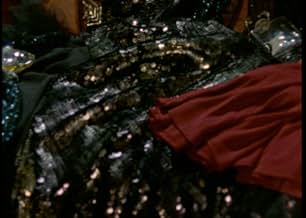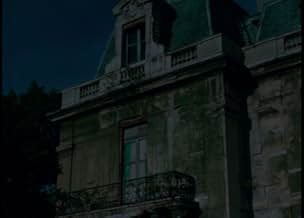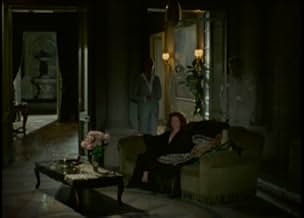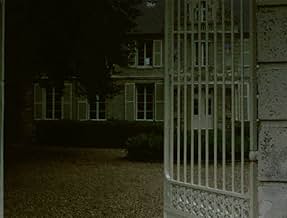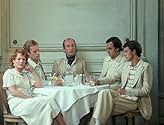IMDb-BEWERTUNG
6,1/10
2773
IHRE BEWERTUNG
Anne-Marie Stretter, Ehefrau eines französischen Diplomaten, lebt im Indien der 1930er Jahre. Sie nimmt sich viele Liebhaber, während um sie herum Unterdrückungssysteme zerfallen.Anne-Marie Stretter, Ehefrau eines französischen Diplomaten, lebt im Indien der 1930er Jahre. Sie nimmt sich viele Liebhaber, während um sie herum Unterdrückungssysteme zerfallen.Anne-Marie Stretter, Ehefrau eines französischen Diplomaten, lebt im Indien der 1930er Jahre. Sie nimmt sich viele Liebhaber, während um sie herum Unterdrückungssysteme zerfallen.
- Regie
- Drehbuch
- Hauptbesetzung
- Auszeichnungen
- 3 Nominierungen insgesamt
Michael Lonsdale
- Le vice-consul de Lahore
- (as Michel Lonsdale)
Satasinh Manila
- Voix de la mendiante
- (Synchronisation)
Nicole Hiss
- Voix intemporelle
- (Synchronisation)
Monique Simonet
- Voix intemporelle
- (Synchronisation)
Viviane Forrester
- Voix intemporelle
- (Synchronisation)
Dionys Mascolo
- Voix intemporelle
- (Synchronisation)
Marguerite Duras
- Voix intemporelle
- (Synchronisation)
Françoise Lebrun
- Voix de la réception
- (Synchronisation)
Benoît Jacquot
- Voix de la réception
- (Synchronisation)
Nicole-Lise Bernheim
- Voix de la réception
- (Synchronisation)
- (as Nicole Lise Bernheim)
Kevork Kutudjan
- Voix de la réception
- (Synchronisation)
Daniel Dobbels
- Voix de la réception
- (Synchronisation)
Empfohlene Bewertungen
This film was a real surprise when I discovered it in the early '90s and it became one of my favorites. I enjoyed the general slow pace of the film, its dreaminess and yet its inner violence.It's exactly what I imagine tropical climates do to influence your mood .In the same vein Marguerite Duras made "L' Amant ", a semi autobiographical film.
Anyway, you CAN find the video VHS-SECAM . I "stumbled" on it in a bookshop in Montpellier a couple of years ago. Here are the details :
India SONG Ecrit par Marguerite Duras
Entretiens Dominique Noguez Réalisation Jérôme Beaujour et Jean Mascolo Benoît Jacob Vidéo 2001
Anyway, you CAN find the video VHS-SECAM . I "stumbled" on it in a bookshop in Montpellier a couple of years ago. Here are the details :
India SONG Ecrit par Marguerite Duras
Entretiens Dominique Noguez Réalisation Jérôme Beaujour et Jean Mascolo Benoît Jacob Vidéo 2001
I was taken aback at first - the complete absence of spoken dialogue from the cast was a bit unnerving - instead, the film consists of two strands, visual and aural. Visually, the film is slow, languorous and visually sensual. It is almost a 'silent' film. Aurally, the film consists of voices over, providing not so much a narrative as recollections. The voices over (not being a fluent French speaker I had to rely on sub-titles) are telling a story of events that happened in the past whilst the cast act out the events as though they are the ghosts of the buildings in which the events were played out. But there is a story - of a woman married to a French diplomat, living for the time being in Calcutta, who takes lovers to relieve the tedious boredom of social niceties (and the heat, dust and flies). This story is punctuated by one scene in which someone who has fallen in love with her makes his feelings known to her and then, betraying the norms of his society, declares his feelings and his despair, by getting emotional about it - very emotional. I was transfixed. Fortunately, I watched it on DVD having recorded it from BBC4 - so I've got it to watch again, as I shall most certainly do.
It's unfortunate that this film is not available in vhs or dvd form for the viewing public. India Song is a great example of Duras' reworking of the traditional relationship between sound and image. The emphasis on the sound track is a crucial aspect of the film as the viewer is actively challenged to figure out which voice belongs to which character and the chronology of events in the narrative. Ofcourse, this separation of sound and image can be troubling for some and unfortunately Duras' films are often labeled "difficult" . But for those up to the challenge you won't be disappointed.
If you're looking for a typical movie India Song is definitely not for you. The highly experimental movie is both long and smashes a lot of the rules for conventional cinema. It teaches YOU how to watch IT.
The plot, such as it is, is about the wife of a French Ambassador living in Calcutta. Bored she engages in a series of love affairs. This information is provided completely in narration that plays over a series of ghost like images in which we see the ambassador's wife dance and walk and flirt with a handful of other people in a mostly empty and abandoned looking mansion. It's essentially a ghost story.
I have nothing against slow films or unconventional ones but this simply wasn't for me. Delphine Seyrig acts out the part of Anne- Marie Stretter, the wife, but watching her I was reminded of that OTHER famous movie she did in 1975, also experimental and unconventional and also directed by a woman who was a cinematic powerhouse: Chantal Akerman. In terms of plot there's not a lot to tie Chantal Akerman's Jeanne Dielmann to Marguerite Duras' India Song, but the two feature a similar style of long shots and repetition. That said I find Jeanne Dielmann by far the easier of the two to watch. While that movie is hypnotizing and entrancing Duras' movie feels stale, like a book of hers that was never quite able to come to fruition.
A movie that perhaps only Duras devotees or Seyrig fans will love.
The plot, such as it is, is about the wife of a French Ambassador living in Calcutta. Bored she engages in a series of love affairs. This information is provided completely in narration that plays over a series of ghost like images in which we see the ambassador's wife dance and walk and flirt with a handful of other people in a mostly empty and abandoned looking mansion. It's essentially a ghost story.
I have nothing against slow films or unconventional ones but this simply wasn't for me. Delphine Seyrig acts out the part of Anne- Marie Stretter, the wife, but watching her I was reminded of that OTHER famous movie she did in 1975, also experimental and unconventional and also directed by a woman who was a cinematic powerhouse: Chantal Akerman. In terms of plot there's not a lot to tie Chantal Akerman's Jeanne Dielmann to Marguerite Duras' India Song, but the two feature a similar style of long shots and repetition. That said I find Jeanne Dielmann by far the easier of the two to watch. While that movie is hypnotizing and entrancing Duras' movie feels stale, like a book of hers that was never quite able to come to fruition.
A movie that perhaps only Duras devotees or Seyrig fans will love.
I've seen India Song two times. The first time I saw it I fell asleep after thirty minutes or so. There's a scream somewhere in the film that woke me up for a while, but it didn't last. Anyway I was intrigued by the way the images and the narration was juxtaposed, they don't really play the same tune. The images are soft, cool and slow, while the narration was telling us about strong emotions. A pretty good picture of the angst of the priviliged classes in colonial service. I sort of missed the details of the plot, but I think I got the essence of the film. The second time I saw it I stayed awake for five reels (I was counting the shiftmarks) but it was still beautiful and I truly enjoyed it. It's a one of a kind movie and I think it should be credited for that.
WUSSTEST DU SCHON:
- WissenswertesDominique Sanda was the first choice for the leading role, but dropped out and was replaced by Delphine Seyrig.
- VerbindungenEdited into Passage des arts: Marguerite Duras, l'écriture et la vie (2021)
Top-Auswahl
Melde dich zum Bewerten an und greife auf die Watchlist für personalisierte Empfehlungen zu.
- How long is India Song?Powered by Alexa
Details
- Erscheinungsdatum
- Herkunftsland
- Offizieller Standort
- Sprache
- Auch bekannt als
- 印度之歌
- Drehorte
- Produktionsfirmen
- Weitere beteiligte Unternehmen bei IMDbPro anzeigen
Box Office
- Budget
- 254.542 FRF (geschätzt)
- Weltweiter Bruttoertrag
- 9.308 $
Zu dieser Seite beitragen
Bearbeitung vorschlagen oder fehlenden Inhalt hinzufügen



